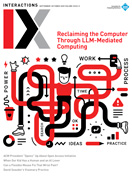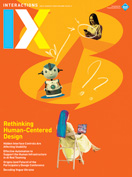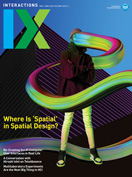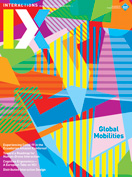Table of Contents
VOLUME XXVIII.2 March - April 2021
-
WELCOME
-
Global mobilities
Alex Taylor, Daniela Rosner, Mikael Wiberg
The global ubiquity of technology is a striking feature of both the 21st century and late capitalism. Yet when, in the early 1990s, Mark Weiser famously imagined computing everywhere, embedded in the objects and surfaces that surround us, he paid little attention to what this vision of ubiquitous computing…
-
-
What are you reading?
-
What are you reading? Angela Okune
Angela Okune

This piece touches on a few readings that have helped me think about the continuities and discontinuities in the production of race around the world. I am currently working on an article for a forthcoming special collection in Engaging Science, Technology, and Society (https://estsjournal.org/index.php/ests), an open access journal published…
-
-
Blog@IX
-
Covid-19 and challenges for learning-technology adoption in Pakistan
Muhammad Zahid Iqbal, Abraham Campbell

Creating educational disruption everywhere, the Covid-19 pandemic has hindered the lives of students and, sadly, will probably have a lasting impact on their future academic lives. What has gone relatively unnoticed is that it has created far more difficulties in developing countries. This is due to the fact that…
-
-
Exhibit X
-
Functional fictions for multispecies cooperation
Sjef van Gaalen

The Zoöp Project, initiated by Klaas Kuitenbrouwer, aims to formulate a practical answer to the question: How can we make the world habitable for humans and nonhumans in the long term? A zoöp is a new type of cooperative legal entity, offering membership to humans and multispecies ecological communities.…
-
-
Columns
-
Inverting mobility
Jonathan Bean

I live in the U.S. A little less than a year ago, I, along with the other 328 million people who live here and countless others around the world, confronted a profound shift in mobility. You might remember this time, as I do, with a particular wistful clarity. For…
-
Movement, time, and space, two ways
Jaz Choi, Anne Galloway

Let us begin by acknowledging the ongoing Covid-19 pandemic and its profound effects on people's lives. Since the global outbreak, the demand for the mobility of a wide range of things continues to increase, while others are under strict control. This includes viral and material matters, as well as…
-
Ignored intersections
Gopinaath Kannabiran

This article is part two of a three-part series exploring the entanglements between queer desire and the design of computer-related technologies. In the first part, I argued for understanding queer desire as a generative force in computing research and knowledge production in STEM-related fields. In this article, I will…
-
-
Making/breaking
-
Learning about the European borderscape on a tandem bicycle
Liam Healy

In 2016, my colleague Jimmy Loizeau and I designed a tandem bicycle to take to Northern France to conduct research on migration in the "Jungle Camp," a refugee and migrant camp that existed near Calais from January 2015 to October 2016. The bicycle was equipped with various recording devices…
-
-
Forums
-
Humble design for sustainable mobility: Relearning what designing means
Mia Hesselgren

Designing for sustainability transitions is not an easy task, and tackling complex sustainability issues requires collaboration. As a postdoctoral researcher in design for sustainable mobility, I keep asking myself: How can I contribute? After 25 years of working as a designer, this was the very question that brought me…
-
UX of data: Making data available doesn’t make it usable
Laura Koesten, Elena Simperl

Data plays an important part in our daily lives. It shapes how we view the world and, for better or worse, informs the decisions we make. Despite controversies around who collects and does what with data, data-centric work is seen as critical to solving the most complex problems of…
-
A conversation with Iván Chaar López
Sareeta Amrute, Iván López

This second installment of the forum focuses on border-control technologies. While they seem very new, these technologies have a long history that wends its way through the problems of identification and verification as our border passes went digital. Iván Chaar López excavates these histories, the histories of the U.S.-Mexico…
-
Making digital financial services more trustworthy for women
Savita Bailur, Hélène Smertnik

Digital financial services (DFS), which include mobile money transactions, lending, savings, insurance, and other products, are often touted as the path to financial inclusion for women in emerging markets [1]. The gender gap in access to digital financial inclusion remains high, at 33 percent across low- and middle-income countries.…
-
-
Community square
-
SIGCHI conferences: Online
Andrew Kun, David Shamma

The Covid-19 pandemic made physical conferences impossible, thrusting us all into the world of organizing and attending virtual conferences. Almost overnight, SIGCHI volunteers found themselves asking: How can we continue to build inclusive, supportive, and productive communities of researchers and practitioners with fully virtual conferences? These are difficult questions,…
-
-
Space
-
Experiencing Covid-19 in the Ecuadorian Amazon rainforest
Kaleidos Collective

What is it like to experience Covid-19 in the Ecuadorian Amazon rainforest? We found out by speaking with a community of the Shuar, Indigenous people of Ecuador and Peru. Our conversations gave us a sense of the distance that exists between healthcare provided by the Ecuadorian state and caring…
-
-
Features
-
Designing for liberation: Our lives, mobility, and technology
Margaret Jack, Anupriya Tuli

If you have come here to help me, you are wasting your time. But if you have come because your liberation is bound up with mine, then let us work together. —Lilla Watson The overarching question motivating this dialogue is: How can HCI scholars refine their understanding of the…
-
Hand in hand: A situated reflection about knowledge mobilization between textile and digital
Laura Cortés-Rico

Although widely questioned, traditional engineering programs teach students to identify, formulate, and solve problems. I am a professor and researcher of human-computer interaction (HCI) in the multimedia engineering undergraduate program at the Nueva Granada Military University (UMNG), Colombia. This program focuses on approaching problems with computational methods in combination…
-
Middle Eastern reflections on forced migration, solidarity, and HCI research
Reem Talhouk, Eiad Yafi

HCI research with refugees, asylum seekers, and other forcibly displaced populations has grown over the years. Indeed, our passionate community working at the intersection of design and technology has expanded, with several researchers conducting their work in the Middle East, where a large number of refugees reside. However, with…
-
Designing with the internally displaced slum dwellers in Bangladesh
Abdullah Safir, Nusrat Mim, S. Haque, Syed Ahmed

In pursuing human-centered design, we know we need to build sensitivity around people's unique situations. Turning our attention to people's regional and global movements, we come to see that this involves much more than building productive and enjoyable consumer devices. It is about understanding how technologies might entangle with…
-
Lessons from Latin America: Embracing horizontality to reconstruct HCI as a pluriverse
Marisol Wong-Villacres, Adriana Garcia, Karla Badillo-Urquiola, Mayra Machuca, Marianela Felice, Laura Gaytán-Lugo, Oscar Lemus, Pedro Reynolds-Cuéllar, Monica Perusquía-Hernández

The field of HCI has increasingly grown concerned with designing technologies to address societal challenges across the globe. Recognizing that HCI is essentially a Eurocentric field of knowledge, scholars within the field have produced explicit attempts to include a wide array of people, research topics, and design practices, including…
-
How fragmentation can undermine the public health response to Covid-19
Andrew Chen

Responses to Covid-19 have largely been led by local, national, and international public health agencies, who have activated their pandemic plans and opened the epidemiological toolkit of modeling, testing, isolation and movement restrictions, surveillance, and contact tracing. When it comes to contact tracing, it's natural for people to see…
-
The historical CHI video project: Bringing 1983–2002 treasures to the ACM DL and YouTube
Catherine Plaisant, Nat DeMenthon

I still remember the first time I (Catherine) saw the video of "Put That There" demoed by Chris Schmandt. I had just finished my industrial engineering thesis on using voice recognition to help people with severe motor disability control devices around them, so I knew a lot about voice…
-
Toward a roadmap for human-drone interaction
Jessica Cauchard, Mohamed Khamis, Jérémie Garcia, Matjaž Kljun, Anke Brock

The field of human-drone interaction (HDI) has been steadily growing over the past few years, especially as drone technology has become increasingly present in human spaces. The Covid-19 crisis has shown that "drones were ready" [1] and that, beyond taking photos and videos, drones could be used for a…
-
Distributed interaction design: Designing human-centered interactions in a time of social distancing
Abdullah Ali, Meredith Morris, Jacob Wobbrock

At the time of this writing, some countries are still enforcing stay-at-home orders and the world population is continuing to practice self-isolation to slow the spread of the coronavirus. In times of crisis, innovation is essential and human-centered innovation is paramount. Despite decades of improved design and usability practices,…
-
Cognitive ergonomics—A European take on HCI
Anke Dittmar, Dianne Murray, Gerrit van der Veer, Harry Witchel

At a 1982 European meeting focused on cognitive engineering, all participants were psychologists, trying to make control rooms and computer programming languages easier to use from a cognitive perspective. This was the starting point of what is now known as cognitive ergonomics (CE). CE is an academic field that…
-
-
Dialogues
-
Mobility justice: Working through cross-disciplinary perspectives on refugee youth in Uganda
Rachel Clarke, Cuthbert Tukundane

In this article we discuss recent collaborative writing experiences between researchers in the U.K. and Uganda. In early 2020, our team began planning research with young Ugandan refugees on their mobile phone use. Subsequently, numerous pandemic lockdowns thwarted this research and we had to revise our plans. While this…
-
Designing for liberation: Our lives, mobility, and technology
Margaret Jack, Anupriya Tuli

If you have come here to help me, you are wasting your time. But if you have come because your liberation is bound up with mine, then let us work together. —Lilla Watson The overarching question motivating this dialogue is: How can HCI scholars refine their understanding of the…
-
Hand in hand: A situated reflection about knowledge mobilization between textile and digital
Laura Cortés-Rico

Although widely questioned, traditional engineering programs teach students to identify, formulate, and solve problems. I am a professor and researcher of human-computer interaction (HCI) in the multimedia engineering undergraduate program at the Nueva Granada Military University (UMNG), Colombia. This program focuses on approaching problems with computational methods in combination…
-
Middle Eastern reflections on forced migration, solidarity, and HCI research
Reem Talhouk, Eiad Yafi

HCI research with refugees, asylum seekers, and other forcibly displaced populations has grown over the years. Indeed, our passionate community working at the intersection of design and technology has expanded, with several researchers conducting their work in the Middle East, where a large number of refugees reside. However, with…
-
Designing with the internally displaced slum dwellers in Bangladesh
Abdullah Safir, Nusrat Mim, S. Haque, Syed Ahmed

In pursuing human-centered design, we know we need to build sensitivity around people's unique situations. Turning our attention to people's regional and global movements, we come to see that this involves much more than building productive and enjoyable consumer devices. It is about understanding how technologies might entangle with…
-
-
Calendar
-
Calendar
INTR Staff

March CHIIR '21: 6th ACM SIGIR Conference on Human Information Interaction and Retrieval (Online) Conference Dates: March 14–19, 2021 https://www.sigir.org/chiir2021 April IUI '21: 26th International Conference on Intelligent User Interfaces (Online) Conference Dates: April 13–17, 2021 https://iui.acm.org/2021/ LAK '21: 11th International Learning Analytics and Knowledge Conference (Online) Conference…
-
-
Exit
-
And, you hold power
Nia Easley

Contributor: Nia Easley Curator/Editor: Amanda Windle Visible in the exterior Gallery 400 windows along Van Buren Street in Chicago, this text-based work considers ideas of place and belonging amid the ever-changing neighborhood around Gallery 400, as well as in the city of Chicago. Sited in public space, the work…
-



